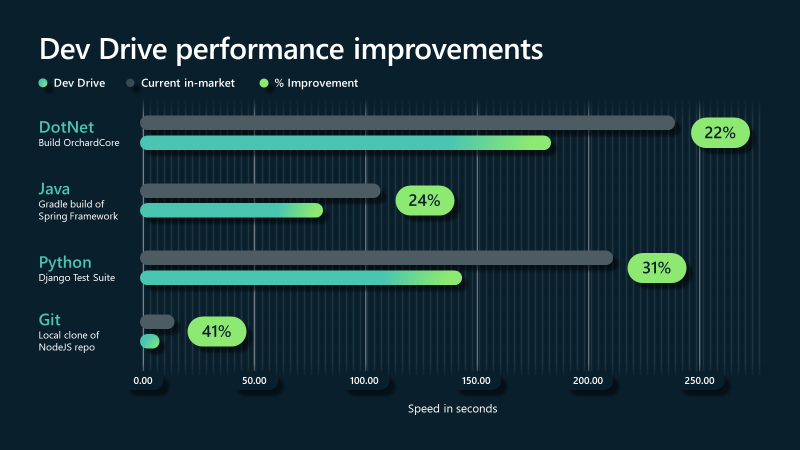

Dev Drive for Performance Improvements in Visual Studio and Dev Boxes!
source link: https://devblogs.microsoft.com/visualstudio/devdrive/
Go to the source link to view the article. You can view the picture content, updated content and better typesetting reading experience. If the link is broken, please click the button below to view the snapshot at that time.

Dev Drive for Performance Improvements in Visual Studio and Dev Boxes!

Grace Taylor
Performance has always been one of our key investment areas for developer tooling in Microsoft. We understand that it’s important for developers to have a fast workflow. That’s why we’re excited to share with you the support of Dev Drives in Visual Studio! Dev Drive for Visual Studio has just been released to help you optimize your workflow and increase your productivity. With Dev Drive, you can create a separate volume on your PC that will improve performance for disk-bound operations such as cloning, building, copying files, and package restore. We measured average improvements in these operations around of 25%! Take a look at the documentation here.
A Dev Drive volume uses ReFS instead of NTFS and is optimized specifically for developer workflows. We also recommend turning Windows Defender to “Async” for most scenarios for optimal perf gains.
Dev Drive is currently available for people who are using the Dev Channel for Windows Insiders. To get started with Dev Drive, create a volume using this documentation and clone or move your source folders to it. Depending on your toolchain, see this section for additional configuration recommendations. For example, we recommend moving the NuGet global-packages folder to this volume for optimal perf gains.
One optimization that Dev Drive provides through the ReFS filesystem is Copy-on-Write (CoW) linking, or block cloning. Instead of fully copying a file, CoW creates a metadata reference to the original data on-disk, so that disk space can be saved and less actual data is copied. You can use this capability to speed up your build by configuring your solutions to use the CopyOnWrite extension for MSBuild. Take a look at this blog post for additional details.
In the future, Dev Boxes will come pre-configured to use Dev Drives so that teams who develop in the cloud will realize these perf gains automatically. Dev Boxes are an Azure service that gives developers access to ready-to-code, project-specific developer environments. Learn more about Microsoft Dev Box here.
If you already have a Dev Drive created on your Windows machine, Visual Studio 17.7 will recognize it when you’re creating a new project and pick that filepath by default. So, not only will Dev Drive make your development tasks faster, but it will also streamline your workflow by integrating with Visual Studio.
Conclusion
Dev Drive is a new feature in Windows that helps you code more and wait less. Give it a try today and see the difference for yourself! Let us know what you think by sharing your feedback in a Developer Community feedback ticket or the Windows feedback hub.
Grace Taylor Product Manager
Follow
Recommend
About Joyk
Aggregate valuable and interesting links.
Joyk means Joy of geeK
